Simultaneous Analysis of Phenoxyethanol and Parabens
Paraben is a generic term for p-hydroxybenzoate esters. Due to their low toxicity in the human body, as well as antiseptic and mold proofing effects, parabens are used as preservatives in medicines, cosmetics, and foods. The Japanese Pharmacopoeia (sixteenth edition) lists 4 parabens: methyl p-hydroxybenzoate, ethyl p-hydroxybenzoate, propyl p-hydroxybenzoate, and butyl p-hydroxybenzoate.
Phenoxyethanol is another component used as a germicide and antiseptic in cosmetics. It is a naturallyoccurring compound that is found in substances such as green tea.
Phenoxyethanol is often used in combination with parabens in cosmetics to reduce the added paraben content. The Japanese Standards for Cosmetics (public notice of the Ministry of Health, Labour and Welfare) restricts the use of parabens and phenoxyethanol in cosmetics to 1 g each per 100 g of cosmetics.
In this presentation, we will introduce and examine the simultaneous analysis of phenoxyethanol and parabens.
Simultaneous analysis of phenoxyethanol and parabens
Measurement examples for standard samples
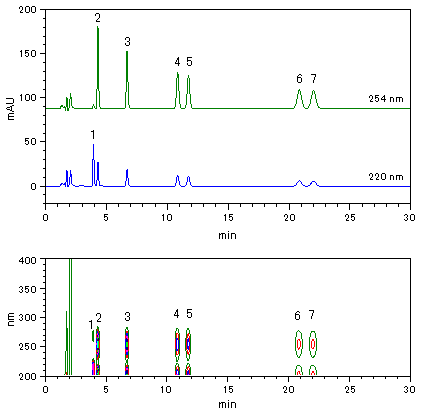
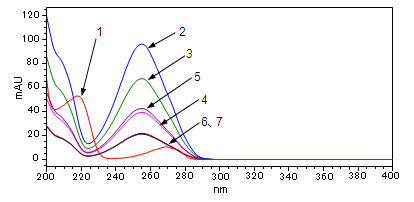
Standard Samples
- 2-Phenoxyethanol
- Methyl p-hydroxybenzoate
- Ethyl p-hydroxybenzoate
- Isopropyl p-hydroxybenzoate
- Propyl p-hydroxybenzoate
- Isobutyl p-hydroxybenzoate
- Butyl p-hydroxybenzoate 10 mg/L each (prepared with methanol)
Conditions
| Column | HITACHI LaChrom C18 (5 µm) (4.6 mmI.D. x 150 mm) |
|---|---|
| Elute | CH3CN/0.1% H3PO4*(v/v) = 35/65 (v/v) (*H3PO4is of a special grade (85.05%) |
| Flow rate | 1.0 mL/min |
| Column Temperature | 40°C |
| Detection | DAD 220, 254 nm |
| Injection vol. | 10 µL |
System configuration
5110 Pump
5210 AutoSampler
5310 Column Oven
5420 UV-VIS Detector
Empower2 Data Processing System
The measurement results from the diode array detector show that 2-phenoxyethanol and the parabens, respectively, have optimum detection wavelengths at 220 nm and 254 nm.
Accordingly, the following samples were measured with the diode array detector, and chromatograms at these optimum wavelengths were obtained.
Linearity
Fair linearity was obtained for each sample, with r2 = 0.999 or greater in the 0.1 - 50 mg/L concentration range
Example measurement of a real sample (1)
Commercial face lotion
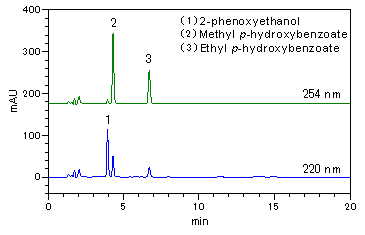
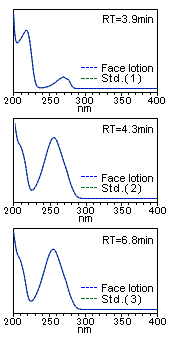
for the standard sample
Sample pretreatment
0.1 g of each sample was diluted to 10 mL with ethanol and filtered with a 0.2 µm filter.
Result
In this sample, (1) 2-phenoxyethanol, (2) Methyl p-hydroxybenzoate, and (3) Ethyl p-hydroxybenzoate were detected.
In addition, each peak matches well with a corresponding peak of the standard sample. The analysis results show the usage of phenoxyethanol and parabens in this sample lotion as germicides and antiseptics in cosmetics.
Example measurement of a real sample(2)
Commercial hand cream
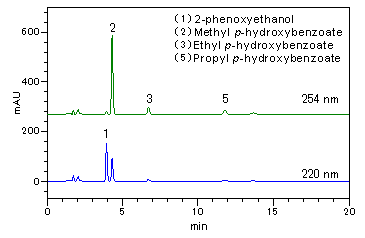
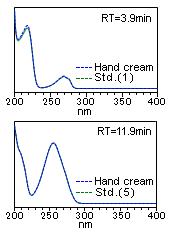
for the standard sample
Sample pretreatment
0.1 g of each sample was diluted to 10 mL with ethanol and filtered with a 0.2 µm filter.
Result
In this sample, (1) 2-phenoxyethanol, (2) Methyl p-hydroxybenzoate, (3) Ethyl p-hydroxybenzoate, and (5) Propyl p-hydroxybenzoate were detected.
The results reveal the usage of phenoxyethanol and parabens in the sample hand cream as germicides and antiseptics.
* Reference: Osaka Prefectural Institute of Public Health Report No. 47, 2009
* This analysis sample was provided by Miki Nakajima, Associate Professor of College of Medical, Pharmaceutical,and Health Science School of Pharmacy at Kanazawa University.
NOTE:
These data are an example of measurement; the individual values cannot be guaranteed.
The system is for research use only, and is not intended for any animal or human therapeutic or diagnostic use.
In order to read a PDF file, you need to have Adobe® Reader®
